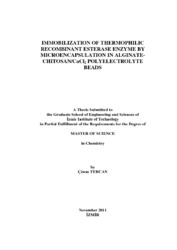Please use this identifier to cite or link to this item:
https://hdl.handle.net/11147/3162Full metadata record
| DC Field | Value | Language |
|---|---|---|
| dc.contributor.advisor | Şanlı Mohamed, Gülşah | - |
| dc.contributor.author | Tercan, Cisem | - |
| dc.date.accessioned | 2014-07-22T13:51:00Z | - |
| dc.date.available | 2014-07-22T13:51:00Z | - |
| dc.date.issued | 2011 | - |
| dc.identifier.uri | http://hdl.handle.net/11147/3162 | - |
| dc.description | Thesis (Master)--İzmir Institute of Technology, Chemistry, İzmir, 2011 | en_US |
| dc.description | Includes bibliographical references (leaves: 73-78) | en_US |
| dc.description | Text in English; Abstract: Turkish and English | en_US |
| dc.description | xi, 83 leaves | en_US |
| dc.description.abstract | In recent years, enzyme immobilization has gained importance for design of artificial organs, drug delivery systems, and several biosensors. Polysaccharide based natural biopolymers used in enzyme or cell immobilization represent a major class of biomaterials which includes agarose, alginate, dextran, and chitosan. Especially, chitosan has used many biomedical applications, including tissue engineering, because of its biodegradability and biocompatibility, non-toxicity and degradation in the body. In this research, Recombinant esterase enzyme was purified from Thermophilic Bacillus sp. That was isolated from Balçova (Agamemnon) Geothermal region in İzmir by using one-step affinity purification chromatography. In the second step, purified enzyme encapsulated in alginate-chitosan/CaCl2 polyelectrolyte beads that were prepared by adding dropwise a protein-containing sodium alginate mixture into a chitosan-CaCl2 crosslinker solution. And then the polyelectrolyte beads were stabilized in at the same crosslinker solution 30 minutes more. In the third step, the effect of different conditions were tested such as temperature and pH, bead diameter, reuse of beads. Also the effects of inhibition of CaCl2, ZnCl2, MgCl2, CuSO4, MgSO4, Sodium dodecyl sulfate (SDS) and Triton X-100 onto the immobilized and free enzyme activity were studied. In the last step, analysis of surface morphologies of polyelectrolyte beads were determined and examined by means of Scanning Electron Microscope. | en_US |
| dc.language.iso | en | en_US |
| dc.publisher | Izmir Institute of Technology | en_US |
| dc.rights | info:eu-repo/semantics/openAccess | en_US |
| dc.subject.lcsh | Immobilized enzymes--Biotechnology | en |
| dc.subject.lcsh | Microencapsulation | en |
| dc.subject.lcsh | Alginates | en |
| dc.subject.lcsh | Calcium chloride | en |
| dc.subject.lcsh | Chitin | en |
| dc.subject.lcsh | Chitosan | en |
| dc.subject.lcsh | Enzymes--Purification | en |
| dc.subject.lcsh | Thermophilic bacteria | en |
| dc.title | Immobilization of Thermophilic Recombinant Esterase Enzyme by Microencapsulation in Alginate-chitosan/Caci2 Polyelectrolyte Beads | en_US |
| dc.type | Master Thesis | en_US |
| dc.institutionauthor | Tercan, Çisem | - |
| dc.department | Thesis (Master)--İzmir Institute of Technology, Chemistry | en_US |
| dc.relation.publicationcategory | Tez | en_US |
| dc.identifier.wosquality | N/A | - |
| dc.identifier.scopusquality | N/A | - |
| item.openairecristype | http://purl.org/coar/resource_type/c_18cf | - |
| item.cerifentitytype | Publications | - |
| item.fulltext | With Fulltext | - |
| item.languageiso639-1 | en | - |
| item.grantfulltext | open | - |
| item.openairetype | Master Thesis | - |
| Appears in Collections: | Master Degree / Yüksek Lisans Tezleri | |
Files in This Item:
| File | Description | Size | Format | |
|---|---|---|---|---|
| T00975.pdf | MasterThesis | 2.14 MB | Adobe PDF |  View/Open |
CORE Recommender
Page view(s)
226
checked on May 5, 2025
Download(s)
142
checked on May 5, 2025
Google ScholarTM
Check
Items in GCRIS Repository are protected by copyright, with all rights reserved, unless otherwise indicated.